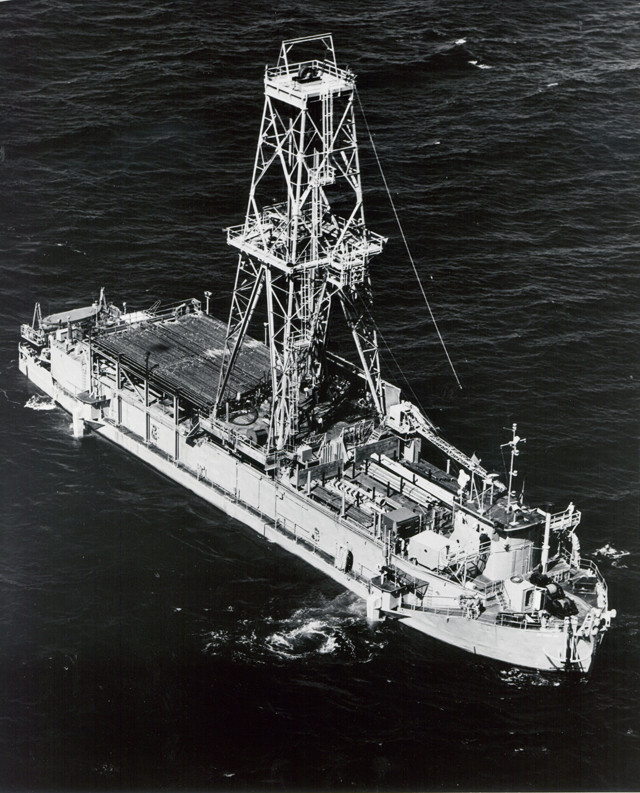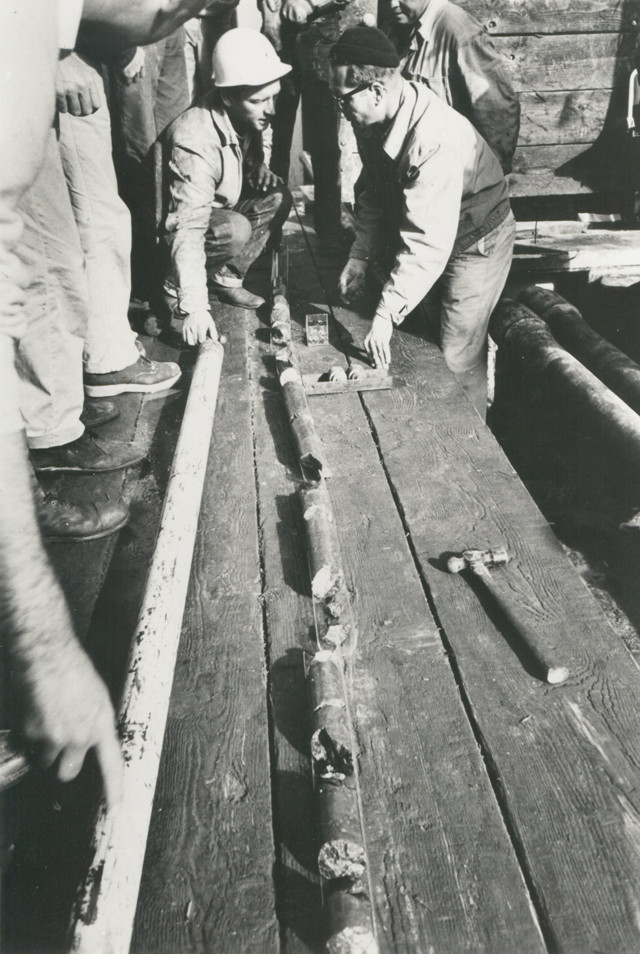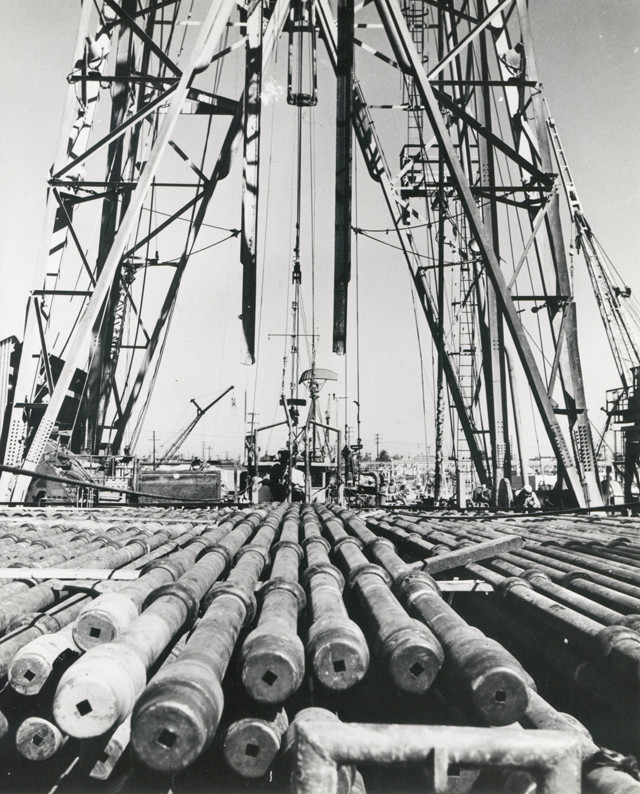
by Sara E. Pratt Wednesday, July 6, 2016

Early near-shore trials of the CUSS I drillship occurred off La Jolla, Calif., where the writer John Steinbeck noted that the barge, with its drilling derrick rising amidship, had the "sleek race lines of an outhouse standing on a garbage scow." Credit: Willard Bascom, National Academy of Sciences.
Since its inception in the 1960s, the ocean drilling program — an international research program that explores the world’s ocean basins — has logged hundreds of thousands of hours of ship time traveling the world’s oceans, drilling boreholes and retrieving cores of sediment and rock that have revealed Earth’s deep history and structure.
Today, the drilling program’s flagship, the 143-meter-long R/V JOIDES Resolution, can drill in water more than 8,200 meters deep and has retrieved cores from 1,500 meters under the seafloor. Fifty years ago, such feats of engineering were unimaginable to all but a few intrepid scientists and engineers who, looking for the earth sciences to undertake a global ocean exploration program tantamount to the space program, embarked upon the first attempt at deep-ocean drilling. Their efforts would go on to revolutionize the earth sciences.
In the late 1950s, the oil industry had conducted ship-based drilling on the continental shelf in water depths up to 120 meters. A drillship must remain in a fixed position over a borehole for a month or more at a time. On the continental shelf, ships can be anchored, essentially creating a temporary drilling platform. However, once a ship crosses the continental slope, depths increase rapidly and anchoring a ship is impossible in kilometers of water. In deepwater, scientists had retrieved 10-meter cores of the seafloor using weighted core tubes driven by gravity. Deepwater drilling had not yet been attempted because no one had yet discovered how to stabilize a ship.
Drilling was a challenge as well. On land, boreholes are lined with a casing that stabilizes and guides a drill bit to its target. With no way to steady a ship against the onslaught of waves and weather, or to protect the drill head from the motion of the ship, the idea of dropping a drill string in thousands of meters of water was considered unfeasible.
Such were the challenges taken up in 1957 by a small group called the American Miscellaneous Society (AMSOC), which included the now-legendary marine geophysicists Walter Munk and Roger Revelle at Scripps Institution of Oceanography, Harry Hess at Princeton University, and Maurice Ewing at Columbia University.
However, solving the engineering problems associated with deepwater drilling was merely the first step of the society’s larger goal. Munk, a member of the National Science Foundation’s Earth Science Panel, thought the earth sciences should embark upon a deep Earth exploration and research program equivalent in scale to NASA’s burgeoning space exploration program.
The plan: to drill through Earth’s crust and retrieve a sample of the mantle.

The first deep-ocean drilling project began in the Pacific in March 1961 and successfully recovered a sediment core from beneath 3,800 meters of water. Credit: Willard Bascom, National Academy of Sciences.
The crust-mantle boundary is marked by the Mohorovičić Discontinuity, which was named for Andrija Mohorovičić, the Croatian geologist who first proposed its existence in 1909. This boundary, called the Moho for short, is closer to the surface under the oceans than under the continents. The average thickness of continental crust is 35 kilometers thick, whereas oceanic crust averages a mere 5 kilometers.
After funding was received from the National Science Foundation in 1958, the project was undertaken jointly by the National Academy of Sciences, the National Research Council and AMSOC. Willard Bascom of Scripps was named director and aptly named the project to drill a borehole to the Moho, Project Mohole. Project Mohole was to include three phases: an experimental drilling program; an intermediate vessel program; and, finally, drilling to the Moho.
In phase I, Bascom’s team would have to drill in water 30 times deeper than anyone had drilled before. The first step was to find a worthy ship, outfit it for the task, and solve the positioning problem. The team chose the CUSS I — a former Navy barge converted to a shallow-water drillship by a consortium of Continental, Union, Superior and Shell oil companies — because it could be modified and was large enough to carry the length of drill string required.
The second step was to solve the ship stabilization problem, which was done with arguably one of the most important nautical inventions of all time: dynamic positioning. The team outfitted the ship with four huge outboard engines that would act as thrusters to constantly correct the ship’s position, which was tracked by radar and sonar buoys deployed around the drill site. Dynamic positioning could keep the ship stationary over a point on the seafloor for months, and reduce the mechanical stress on the drill string caused by wind and waves.
In March 1961, just four years after the first deep-ocean drilling was proposed, the CUSS I steamed out of San Diego, Calif., toward the drill site 65 kilometers off the coast of Guadalupe Island, Mexico, where drilling operations began in 3,800 meters of water. By April, a diamond bit chewed through 200 meters of sediment and 14 meters of basalt, the deepest oceanic rock that had been retrieved to date.
The first attempt at deep-ocean drilling had proven a success.

Drill pipe for the first deepocean drilling project stacked on the deck of the CUSS I. Credit: Willard Bascom, National Academy of Sciences.
Over the next few years, the Project Mohole team drilled several more experimental holes, one of which reached more than 180 meters. But the relationship among the program’s administrative partners deteriorated and the AMSOC Committee eventually dissolved. In the end, Project Mohole failed to reach the mantle. It was cancelled in 1966, before phase II was completed, due to lack of funding. Although the main goal of Project Mohole was not achieved, the program’s legacy has been a success, with discoveries that revolutionized our understanding of Earth and the processes that shaped it through geologic time.
In the short term, the oil industry — which had initially been skeptical of Project Mohole — quickly adopted the now-proven dynamic positioning technology. The technology opened up vast new areas of the oceans to exploration and spurred the rapid escalation of the scientific ocean drilling program.
In 1964, a consortium of research institutions called the Joint Oceanographic Institutions for Deep Earth Sampling (JOIDES) was formed. Two years later, the National Science Foundation instituted the Deep Sea Drilling Project based at Scripps, which, in 1968, launched the ship Glomar Challenger, which played a role in some of the most important earth science discoveries ever made.
On Leg 3 in the southern Atlantic Ocean in January 1969, for example, the Glomar Challenger drilled into the mid-ocean ridge and unearthed evidence of continental drift and a young age for the seafloor, confirming the nascent theory of plate tectonics. In May 1978, on Leg 60, the ship cored in the deepest water to date, 7,034 meters, near the Mariana Trench in the southern Pacific.
The ocean drilling program became international in 1975 when France, Germany, Japan, the United Kingdom, and the Soviet Union joined JOIDES, initiating the International Program for Ocean Drilling. In 1985, the formation of the Ocean Drilling Program (ODP) made another leap forward with the launch of the new drillship, the R/V JOIDES Resolution. On Feb. 23, 1993, during Leg 148, a team on the Resolution drilled the deepest ocean borehole: Hole 504B, which reached 2,111 meters — still several thousand meters away from the Moho.
Project Mohole was inspired by the space program, which was driven by the moon race. Likewise, Project Mohole spurred a race to the mantle when a Russian team began drilling — through continental crust — on the Kola Peninsula near the Arctic Circle in 1970. By 1989 when drilling stopped, the Kola Superdeep Borehole had reached a depth of 12 kilometers, about a third of the way through the crust. It remains the deepest borehole ever drilled on Earth, but it still fell far short of reaching the Moho.
Although Project Mohole was abandoned almost half a century ago, the race to retrieve, not a moon rock, but a mantle rock, is still on.
In June 2011, the Integrated Ocean Drilling Program, an international collaboration that succeeded the ODP in 2004, released a report titled Project Mohole Initial Feasibility Study for 2017 Drilling. The study concluded: “Drilling to the mantle is certainly feasible and there are existing industry solutions to many of the technological challenges associated with drilling this type of borehole.”
In the meantime, the collection of correspondence, reports, meeting minutes, clippings and artifacts related to the original Project Mohole has been archived at the National Academy of Sciences in Washington, D.C., where, it is noted, the files have reached a depth of nearly five meters.
© 2008-2021. All rights reserved. Any copying, redistribution or retransmission of any of the contents of this service without the expressed written permission of the American Geosciences Institute is expressly prohibited. Click here for all copyright requests.